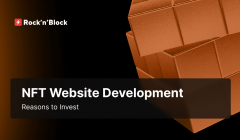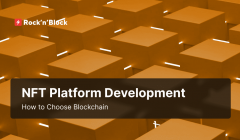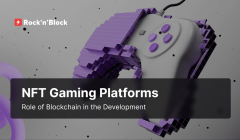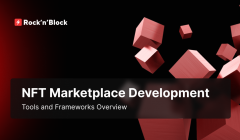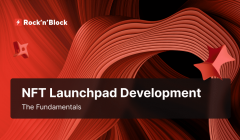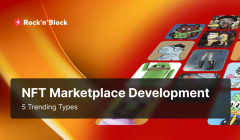NFT Smart Contract Development Essentials
03 May 2024This article delves into the fundamental aspects of NFT smart contract development, exploring the intricate relationship between NFTs and smart contracts. We will embark on a comprehensive journey, from understanding the basics of NFTs and smart contracts to delving into the intricacies of token standards and the NFT smart contract development key functions.

Table of Contents:
-
Overview of NFTs and Smart Contracts
-
Token Standards
-
Importance of NFT Smart Contract Development
-
NFT Smart Contract Development Functions
-
Minting Function
-
Transfer Function
-
Burn Function
-
Royalties in NFT Smart Contract Development
-
Access and Ownership Controls
-
NFT Smart Contract Development Process
-
Conclusion
Overview of NFTs and Smart Contracts
NFTs are unique tokens that represent ownership of digital or physical items, often stored on a blockchain. Unlike cryptocurrencies such as Bitcoin or Ethereum, NFTs are not interchangeable, each carrying a distinct value and identity.
Smart contracts development forms the backbone of this transformative technology, as these contracts are self-executing agreements whose terms are written directly into the code, enabling secure and transparent transactions. Smart contracts are autonomous scripts that facilitate, verify, or enforce the transaction or performance of a contract, eliminating the need for intermediaries. When applied to NFTs, they enable the creation, transfer, and validation of ownership in a secure and transparent manner.
NFT development relies on the symbiotic relationship, where token standards define what tokens represent, and smart contracts determine how they behave in a decentralized environment.
Token Standards
ERC-721: The Pioneer Standard
ERC-721 stands as the pioneer standard for non-fungible tokens on the Ethereum blockchain. This standard defines a set of rules for creating unique tokens with distinct properties. Each token is distinct from one another, making ERC-721 the go-to standard for representing ownership of digital or physical assets on the blockchain.
The uniqueness of ERC-721 tokens makes them ideal for representing digital art, collectibles, and other indivisible assets.
ERC-1155: The All-in-One Standard
While ERC-721 laid the foundation for NFTs, ERC-1155 takes a step further by introducing a more versatile standard.
One of the key advantages of ERC-1155 is its efficiency in terms of gas costs. Creating multiple tokens in a single transaction can significantly reduce the overall cost compared to deploying separate ERC-721 contracts for each unique token.
In addition to efficiency, ERC-1155 enables the creation of semi-fungible tokens (SFTs), which have characteristics of both fungible and non-fungible tokens. This allows developers to represent assets that can be partially divisible, offering new possibilities for use cases such as in-game items with varying levels of rarity.
Importance of NFT Smart Contract Development
The significance of NFT smart contract development cannot be overstated in the realm of decentralized digital assets. Several key factors contribute to the importance of focusing on the NFT smart contracts development.
1. Digital Ownership and Authenticity
NFTs provide a mechanism for establishing true ownership and authenticity of digital assets. Smart contracts, as programmable agreements, ensure the secure and immutable representation of ownership, combating issues of piracy and unauthorized duplication.
2. Decentralization and Interoperability
The decentralized nature of blockchain, combined with smart contracts, fosters a global and open ecosystem. NFTs can be created, traded, and utilized across different platforms, allowing for a more inclusive and diverse landscape.
3. Empowering Creators and Artists
NFTs empower creators by enabling them to tokenize and monetize their digital works directly. Through smart contracts, artists can define royalty structures, ensuring they receive a percentage of any future sales, even in secondary markets.
4. Efficiency and Transparency
Smart contracts simplify the NFT transaction process by reducing the need for intermediaries. This improves efficiency and transparency, as the contract terms are stored on the blockchain for all parties to verify.
5. Innovation in Digital Collectibles
NFT smart contracts development enables the creation of innovative digital collectibles, including virtual art, music, and real estate tokenization. As the technology progresses, it opens up possibilities for new and exciting forms of digital self-expression.
Understanding the intricacies of NFT smart contract development is not only essential for NFT development companies but also for anyone seeking to navigate and contribute to the dynamic landscape of digital ownership and creativity.
NFT Smart Contract Development Functions
NFT smart contract development is essential for creating, transferring, and, if necessary, destroying unique digital assets. It is important for developers, users, and artists to understand these functions when navigating the decentralized landscape of digital ownership, so let’s explore them below.
Minting Function
Minting function involves creating new tokens and is similar to minting coins. The metadata for an NFT, including information such as the title, creator, and description, is typically provided during the minting process. This provides important context and details about the digital asset. The minting process can be initiated by users, artists, or developers, giving the token unique properties that make it truly one-of-a-kind.
Minting is facilitated by interacting with a smart contract that adheres to established NFT standards (ERC-721 or ERC-1155) on the Ethereum blockchain. This smart contract contains functions that enable users, artists, or developers to create new tokens.
Transfer Function
NFTs enable secure and transparent ownership transfers through smart contract functions that update blockchain ownership records. The smart contract validates the transaction's authenticity and updates ownership details when an NFT is transferred between wallets.
Blockchain technology ensures an indisputable record of ownership changes, making it particularly valuable in the context of digital art and collectibles where proof of ownership and authenticity are paramount. Smart contract development for NFT transfers empower users to buy, sell or trade their digital assets with confidence, free from the risks associated with centralized platforms.
Burn Function
The "burn" function in NFT smart contract development refers to the intentional destruction or removal of an NFT from circulation. The burn function is often used for managing limited editions, reducing token supply, or allowing token owners to voluntarily remove their NFTs from existence. It can enhance the rarity and exclusivity of certain tokens, thus contributing to their higher perceived value. NFT project developers integrate the burn function within smart contracts to ensure a controlled and immutable process that changes the overall supply of a particular NFT.
Royalties in NFT Smart Contract Development
The implementation of royalties within NFT smart contracts involves encoding specific rules and conditions that govern how revenue from secondary sales is distributed. This process requires careful consideration of the smart contract's architecture and the chosen token standard, whether it be ERC-721 or ERC-1155.
In the case of these standards, NFT smart contract developers can extend the basic functions of the smart contract to include a royalty mechanism. When an NFT is resold, a predefined percentage of the sale price is automatically routed to the creator's wallet. This can be achieved by introducing a royalty payment function that executes upon the completion of a successful secondary sale.
The integration of royalties into NFT smart contract development represents a pivotal shift in empowering creators within the digital landscape. By ensuring that artists receive a fair share of the value generated by their creations throughout their lifecycle, the NFT ecosystem becomes more sustainable and artist-friendly. As the technology continues to evolve, so too will the innovative ways in which smart contracts and royalties contribute to the flourishing world of digital ownership and creativity.
Access and Ownership Controls
Access controls are a crucial aspect of NFT smart contract development. They enhance security, delegate responsibilities, and establish governance models. As the NFT ecosystem evolves, implementing access controls thoughtfully will safeguard digital assets, foster trust among users, and contribute to the sustainable growth of decentralized ecosystems. NFT platform developers can shape the foundation of NFT smart contracts with resilience and adaptability by using access controls judiciously.
Ownership controls in NFT smart contract development refer to mechanisms that regulate and manage the ownership of non-fungible tokens (NFTs) on the blockchain. Here are key aspects of ownership controls:
-
Ownership Transfer Functions: NFT smart contracts include functions for transferring ownership of NFTs from one address to another securely. These functions often have specific access controls to ensure that only authorized parties can initiate transfers.
-
Access Controls: Access control modifiers, like "onlyOwner" or custom roles, restrict certain functions to specific addresses. Owners or designated administrators have privileged access to functions such as minting, burning, or updating contract parameters.
-
Administrative Controls: Certain functions, like pausing or updating contract parameters, are reserved for contract owners or administrators to maintain control and security. These controls prevent unauthorized modifications that could impact the contract's behavior.
-
Multi-Signature Approvals: Multi-signature schemes require approval from multiple parties before certain ownership-related actions are executed. This enhances security and decentralizes decision-making processes.
-
Governance Tokens: Some NFT ecosystems utilize governance tokens to distribute voting power among token holders, influencing decision-making regarding ownership controls.
-
Proxy Contracts: Proxy contracts can be employed for upgradability without sacrificing ownership controls, allowing for the evolution of the smart contract while maintaining security.
Ownership controls are integral to establishing a secure and well-governed NFT ecosystem. They empower developers to define and enforce rules regarding ownership changes, ensuring that NFTs are transferred and managed in a manner consistent with the intended design and purpose of the smart contract.
NFT Smart Contract Development Process
The process of NFT smart contract development involves several key steps that require coding skills, an understanding of the blockchain architecture and security considerations. Primarily, NFT software developers define the logic and functionalities of the smart contract in a programming language compatible with the chosen blockchain, for example Solidity for Ethereum. Selecting the right blockchain for NFT smart contract development is a critical decision that will significantly impact the success and functionality of each of the above steps. Each blockchain has its own unique features, strengths, and considerations.
Learn how to choose blockchain for NFT platform development in our guide!
Once the code is written, it is thoroughly tested to identify and fix any potential vulnerabilities. After successful testing, the smart contract is deployed to the blockchain network, creating a permanent and immutable record of the code's execution.
During deployment, NFT platform developers must consider gas fees, consensus mechanisms, and network-specific constraints. After deployment, users can interact with the NFT smart contract, triggering predefined actions or transactions. Continuous monitoring and updates of the smart contract ensure optimal performance and security. Meticulous attention to detail is paramount in creating reliable and secure smart contracts that execute desired functionalities on the blockchain.
Conclusion
Comprehensive understanding of NFT smart contracts development empowers developers, entrepreneurs, and enthusiasts to contribute to the growing NFT landscape. Ownership is democratized, value transfer is transparent, and royalties are automated in a decentralized future.
As blockchain technology continues to evolve, so too will the capabilities and possibilities of NFT smart contracts, paving the way for new and innovative use cases in the digital realm.
We ❤️ Development
Follow us on social media to receive the hottest blockchain development updates
Twitter ⚡️Telegram⚡️LinkedIn⚡️Facebook⚡️Linktree
